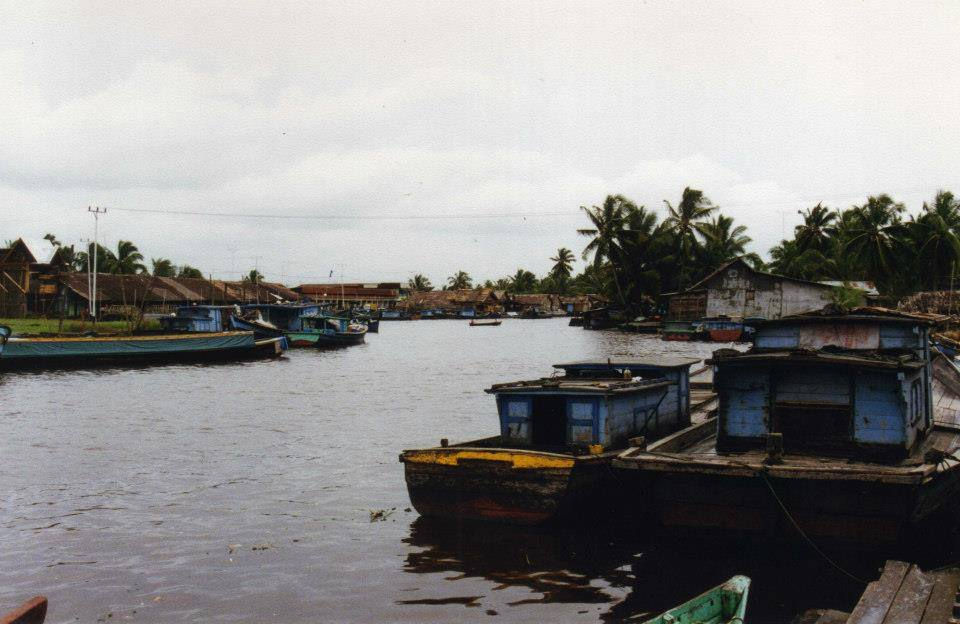Malaysia: Batang Ai
- Matthew P G

- May 21, 2022
- 3 min read



Longhouse, Batang Ai, Sarawak, Malaysia. February 1997
Headhunters!!!
On the Big Borneo Adventure we ended up at a Hilton property in the interior of the island on the Malaysian (Sarawak) side. A huge hydro dam had been constructed and as a bid to develop the area, a hotel was built on one of the hills overlooking the lake. The hotel was not memorable other than the style was built to mimic the local "longhouses" of the indigenous Iban tribe. The overall effect fell flat - it looked more like some errant cargo warehouse from a container port that had been abandoned lakeside. The hydro lake was just a muddy expanse of water in a clear-cut rainforest valley. This was Borneo - the weather was hot and steamy year round - no one was ever going to be hanging out poolside taking in that mosquito-filled, muddy water view. There was one attraction, though. The hotel sponsored boat tours up the river to visit "real native people" in their "real environment". My older self cringes just writing those words "real native people".
We got on a boat and buzzed upstream out of the lake. We were surrounded by tropical rainforest in an explosion of green on either side of the river. Birdlife abounded. Since we had lived in Indonesia for years by that point, we were unimpressed. We saw jungle plenty of times - we wanted to see the "Dayaks".
"Dayak" is, in fact, the Malay (and also English) term for the natives of Borneo. Although not pejorative, the locals don't like it because it lumps them all into one group the same way "American Indian" does with all the tribes of North America. This part of Borneo was Iban country - the famous headhunters of Borneo.
We arrived at the boat landing and scrambled up the bank to find a long structure on stilts with a series of doors opening to the inside from one long porch. The entry steps to that porch were more like a ladder. Their old folk must have been spry. Under the raised house were a variety of domesticated animals and a lot of garbage. This was a "longhouse" and, although the interior was actually mostly open, each family had their own entrance. This building did not speak of tradition (it was made of corrugated metal), it spoke of poverty. We went inside one of the "homes" and were given some local food and then some residents of the house performed traditional dances for us. It was all very contrived and I felt sorry that they were reduced to hawking their local culture to tourists just to get by. The money they received was needed, yet their poverty was still depressing. "Dance for the tourists, Michael, we need the money". (the Iban were Christian).
Brian and I were at an advantage because we spoke Indonesian and we could talk to them. They were so excited to speak with us (how often do tourists visit that they could communicate with?). I wish I remembered more of that interaction, but I only recall how sad we were when we left. We had met the fierce headhunters of Borneo who now were rather shy, downtrodden performers for random tourists from the nearby "Warehouse Hilton".
Interestingly the Iban people might have originated in the Kapuas River area around Pontianak (where we had just visited) [see: Pontianak]. They slowly spread through the interior of the western half of Borneo. There are almost equal numbers of ethnic Iban in Indonesian and Malaysian Borneo and they are one of the largest tribes on the island. Permitted to use their native language in both countries, the Iban and their oral histories are alive and well and being passed along. The Iban have an extremely rich oral history, too, with some anthropologists putting them on par with the ancient Greeks. I give the governments of Malaysia and Indonesia credit that they are not interfering too much in Iban culture. As long as the locals learn Malay/Indonesian in school, they are largely left alone. The poverty in the area is a different story.
One positive effect from that trip was in my change in language and attitude toward people from Borneo. Thereafter, when I met a "Dayak" back in Jakarta (it was rare to meet one, mostly I met ethnic Malays), I always asked their tribe and referred to them by their tribe name. They were usually surprised a foreigner knew anything about them, but they were always appreciative. Don't all of us need to be recognized as who we really are?

Comments